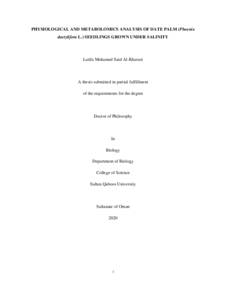Document
Physiological and metabolomics analysis of date palm (Phoenix dactylifera L.) seeding grown under salinity.
Identifier
Al-Kharusiyah, Latifa Mohamed Said (2020). Physiological and metabolomics analysis of date palm (Phoenix dactylifera L.) seeding grown under salinity (Doctoral dissertation, Sultan Qaboos University, Muscat, Oman).
Publisher
Sultan Qaboos University.
Gregorian
2020
Language
English
English abstract
Date palm (Phoenix dactylifera L.) is a major fruit tree in the Middle East and it is a plant
considered to be tolerant to a variety of abiotic stresses, including salinity. However, the
physiological basis of its salinity tolerance is not fully known. The main objective of this thesis
was to understand the salinity tolerance mechanisms in date palm based on physiological
procedures and metabolomics profiles. As a first step toward this objective, Omani date palm
cultivars were screened for tolerance or susceptibility to salt stress. Seedlings from 10
commercially important date palm cultivars were subjected to 240 mM NaCl and several
physiological parameters related to salinity tolerance traits were evaluated upon treatment. The
cultivars were divided into two groups based on the dry weight (DW) of their leaf and root
tissues, a parameter which was used as an indication of healthy growth. The results revealed
that photosynthesis, and the shoot K+
/Na+
ratio were all significantly reduced in the susceptible
cultivars. In addition, the relative water content was higher in the tolerant cultivars in
comparison with the susceptible ones. These results suggest that although date palm is tolerant
to high salinity, there is variation in the tolerance among different cultivars. Shoot Na+
exclusion, photosynthesis, and membrane stability are apparently the main determinants of
tolerance and can be used in salinity tolerance screening of date palm. The results have shown
new very tolerant cultivars (Manoma and Umsila) that could serve as genetic resources for
improved date palm tolerance to salinity. In order to investigate the role of various antioxidants
in salinity tolerance. Two date palm cultivars, contrasting in salinity tolerance, were used as
model plants in a comparative study designed to detect changes in growth, Na+
and K+
uptake,
reactive oxygen species (ROS), and antioxidant accumulations when plants were exposed to salt
stress. The results showed that salinity treatment had a more substantial negative effect on the
growth and photosynthetic pigmentation of the susceptible 'Zabad' cultivar than on the tolerant
'Umsila' cultivar, probably due to the ability of 'Umsila' to accumulate less Na+
and more K+
,
to maintain a normal concentration of ROS and to produce more non-enzymatic antioxidants,
including glutathione, phenolic compounds, flavonoids, and proline. Under salinity, 'Umsila'
could also activate more superoxide dismutase (SOD), catalase (CAT) and ascorbate peroxidase
(APX) than 'Zabad'. These results suggest that the tolerance of 'Umsila' is partially due to the
balanced Na+
and K+
uptake and to the relatively high concentration of ROS-scavenging
metabolites. Plant-water relations, as well as the anatomical characteristics of root tissues of
date palm seedlings, were analyzed when exposed to salinity. The results revealed that while
salinity has negatively affected both cultivars, 'Umsila' exhibited more stable photosynthesis
than 'Zabad' as reflected by the quantum yield (Qy) and the stomatal conductance (gs).
Similarly, 'Umsila' showed a more dynamic root system and efficient water relations than
'Zabad' as demonstrated by the leaf water potential (LWP) and relative water content (RWC)
during salinity. 'Umsila' also accumulated greater abundances of soluble sugars, potassium
(K+
), calcium (Ca+2), proline, glycine betaine, and lignin and formed extra layers of Casparian
strips in the root tissues when the seedlings were grown under saline conditions. In order to
obtain a comprehensive idea about the metabolic profile changes in date palm in response to
salinity, the metabolomic profiles of the salt-tolerant 'Umsila' and salt-susceptible 'Zabad'
cultivars were analyzed when grown under salinity conditions. Changes in the metabolomic
profiles of the leaf and root tissues were determined using hydrophilic interaction liquid
chromatography (HILIC) and reverse-phase liquid chromatography (RPLC) mass spectrometry.
The global untargeted metabolomic analysis showed the presence of 4,878 metabolites
accumulated in leaf and root tissues of the date palm seedlings. Principal component analysis
(PCA) revealed the presence of unique groups of metabolites for each treatment and tissuestype. Pathway analysis showed the involvement of some of these metabolites in the
biosynthesis of several types of membranous lipids and glycolipids molecules such as 18:0-
lyso-phosphatidylethanolamine (lysoPE), and also the synthesis of cell-wall components such
as 16-hydroxy hexadecanoic acid, which is an intermediate metabolite in cutin, suberin and wax
biosynthesis. Moreover, antioxidant flavonoids such as (+)- catechin and epicatechin, vitamins
such as B9, phytohormone-associated compounds such as dihydrozeatin-9-N-glucoside-Oglucoside and osmolytes such as the sulfonic amino acid taurine were all significantly (p ≤ 0.05,
FWER ≤ 0.05) altered in response to salinity in both cultivars. These results indicate that
salinity tolerance in date palm involved a multi-dimensional mechanism, which includes the
modification of the cell-wall and cellular membranes, the production of oxygen species
scavengers, the adjustment of cellular osmotic pressure, and probably the alteration of the
hormonal balance.
Member of
Resource URL
Category
Theses and Dissertations

